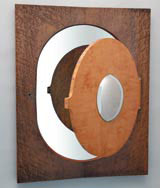Modern madame
In her 70-year career Janette Laverrière has seen all sorts of trends come and go, but her no-nonsense approach has endured. Dominic Lutyens talks to her about her contribution to contemporary interiors

But a fearlessly unconventional, arty upbringing had armed Laverrière with the confidence to face this adversity. Her father, the architect Alphonse Laverrière, and his South African-born wife, Adele, mixed with intellectuals sympathetic to the ideas of the Bauhaus. Laverrière herself was politicised from an early age: when she witnessed a workers’ demonstration she was deeply moved by their plight. Later in life she aimed to create democratic, mass-produced designs, but she could rarely afford to, instead creating interiors and furniture for private clients – albeit liberal intellectuals. Designers like myself wanted very much to create for people who weren’t rich, but it was a struggle. Few manufacturers wanted to take the risk of making our designs,’ she explains.
In 1931 she joined the Paris studio of Art Deco titan Emile-Jacques Ruhlmann. Characteristically, when the Le Corbusier-influenced Laverrière first visited Ruhlmann’s studio, she was shocked to see ‘such bombastic, precious designs’. Yet her first, relatively opulent pieces were Ruhlmannesque.
It was during this period that Laverri̬re started producing more streamlined work Рlow-level seating and dual-function coffee tables with detachable tops, revealing compartments to store magazines. Even so, creating decorative mirrors hung from bronze rings, her style was also fashionably neoclassical. Yet, adorned too with Jean Arp-like abstract organic motifs, her mirrors were part of the 1930s movement called Biomorphic Abstraction (whose exponents included Alvar Aalto and Isamu Noguchi).
In the 1950s and 1960s, she discovered Multipli, a hybrid of plywood and brightly coloured laminate, which led temporarily to her adopting a more pop aesthetic. Since the late 1980s, having abandoned furniture and interiors, she has created mirrors with literary themes. One, Dorian Gray, is wittily surrounded by an empty space enclosed by a gold frame to convey the ‘vanity of Gray’s life’.
Asked today what distinguishes her work from others, she replies: ‘I start from scratch with every new design. I rid myself of preconceptions. If I were to create a new table, I would ask “What type of person is it for?”, “How much should it cost?”, “Can I use new materials?”.’
Laverrière is only moved by new ideas. She asserts that the inflatable furniture of the 1960s was the last example of innovative design.
I wonder what this extraordinarily hard-working designer makes of her compatriots. ‘Part of the problem for young French designers, she says, is that design education in France has gone downhill. Students aren’t taught the basics any more. And her opinion of Perriand and Starck? I get a slightly evasive, diplomatic answer that, to me, suggests she perhaps believes their fame was built more on hype than talent. She doesn’t praise their work but acknowledges, ‘Starck is a very intelligent man, very… C’est tout. They have both made a lot of noise about design, drawn people’s attention to it. It’s good that people like them exist.’
Laverrière’s designs go on show at Rabih Hage, 69-71 Sloane Avenue, London SW3 from 18 November to 8 December
-
Post a comment




